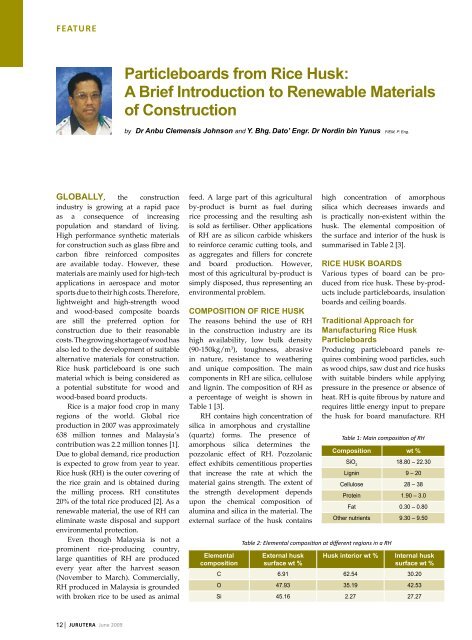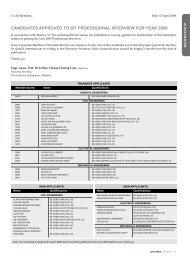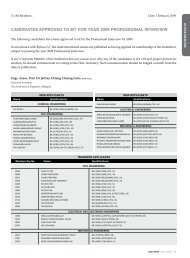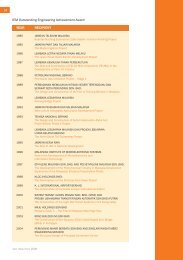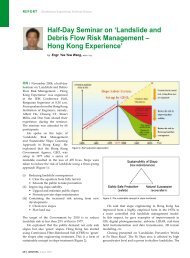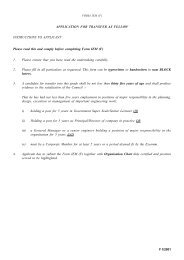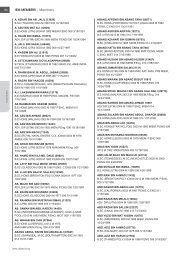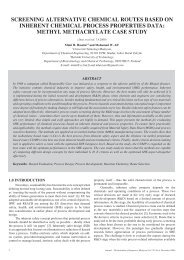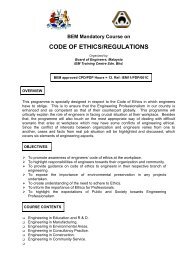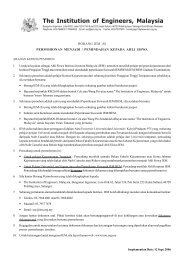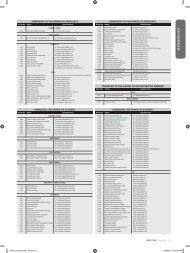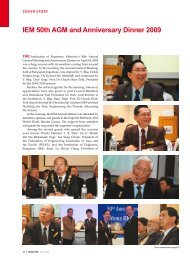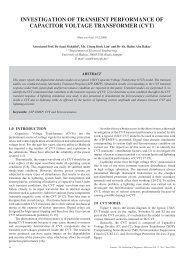particleboards from Rice Husk - Institution of Engineers Malaysia
particleboards from Rice Husk - Institution of Engineers Malaysia
particleboards from Rice Husk - Institution of Engineers Malaysia
You also want an ePaper? Increase the reach of your titles
YUMPU automatically turns print PDFs into web optimized ePapers that Google loves.
feature<br />
Globally, the construction<br />
industry is growing at a rapid pace<br />
as a consequence <strong>of</strong> increasing<br />
population and standard <strong>of</strong> living.<br />
High performance synthetic materials<br />
for construction such as glass fibre and<br />
carbon fibre reinforced composites<br />
are available today. However, these<br />
materials are mainly used for high-tech<br />
applications in aerospace and motor<br />
sports due to their high costs. Therefore,<br />
lightweight and high-strength wood<br />
and wood-based composite boards<br />
are still the preferred option for<br />
construction due to their reasonable<br />
costs. The growing shortage <strong>of</strong> wood has<br />
also led to the development <strong>of</strong> suitable<br />
alternative materials for construction.<br />
<strong>Rice</strong> husk particleboard is one such<br />
material which is being considered as<br />
a potential substitute for wood and<br />
wood-based board products.<br />
<strong>Rice</strong> is a major food crop in many<br />
regions <strong>of</strong> the world. Global rice<br />
production in 2007 was approximately<br />
638 million tonnes and <strong>Malaysia</strong>’s<br />
contribution was 2.2 million tonnes [1].<br />
Due to global demand, rice production<br />
is expected to grow <strong>from</strong> year to year.<br />
<strong>Rice</strong> husk (RH) is the outer covering <strong>of</strong><br />
the rice grain and is obtained during<br />
the milling process. RH constitutes<br />
20% <strong>of</strong> the total rice produced [2]. As a<br />
renewable material, the use <strong>of</strong> RH can<br />
eliminate waste disposal and support<br />
environmental protection.<br />
Even though <strong>Malaysia</strong> is not a<br />
prominent rice-producing country,<br />
large quantities <strong>of</strong> RH are produced<br />
every year after the harvest season<br />
(November to March). Commercially,<br />
RH produced in <strong>Malaysia</strong> is grounded<br />
with broken rice to be used as animal<br />
12 Jurutera June 2009<br />
<strong>particleboards</strong> <strong>from</strong> <strong>Rice</strong> <strong>Husk</strong>:<br />
a brief introduction to Renewable materials<br />
<strong>of</strong> Construction<br />
by Dr Anbu Clemensis Johnson and Y. Bhg. Dato’ Engr. Dr Nordin bin Yunus FIEM, P. Eng.<br />
feed. A large part <strong>of</strong> this agricultural<br />
by-product is burnt as fuel during<br />
rice processing and the resulting ash<br />
is sold as fertiliser. Other applications<br />
<strong>of</strong> RH are as silicon carbide whiskers<br />
to reinforce ceramic cutting tools, and<br />
as aggregates and fillers for concrete<br />
and board production. However,<br />
most <strong>of</strong> this agricultural by-product is<br />
simply disposed, thus representing an<br />
environmental problem.<br />
Composition <strong>of</strong> RiCe <strong>Husk</strong><br />
The reasons behind the use <strong>of</strong> RH<br />
in the construction industry are its<br />
high availability, low bulk density<br />
(90-150kg/m 3 ), toughness, abrasive<br />
in nature, resistance to weathering<br />
and unique composition. The main<br />
components in RH are silica, cellulose<br />
and lignin. The composition <strong>of</strong> RH as<br />
a percentage <strong>of</strong> weight is shown in<br />
Table 1 [3].<br />
RH contains high concentration <strong>of</strong><br />
silica in amorphous and crystalline<br />
(quartz) forms. The presence <strong>of</strong><br />
amorphous silica determines the<br />
pozzolanic effect <strong>of</strong> RH. Pozzolanic<br />
effect exhibits cementitious properties<br />
that increase the rate at which the<br />
material gains strength. The extent <strong>of</strong><br />
the strength development depends<br />
upon the chemical composition <strong>of</strong><br />
alumina and silica in the material. The<br />
external surface <strong>of</strong> the husk contains<br />
elemental<br />
composition<br />
high concentration <strong>of</strong> amorphous<br />
silica which decreases inwards and<br />
is practically non-existent within the<br />
husk. The elemental composition <strong>of</strong><br />
the surface and interior <strong>of</strong> the husk is<br />
summarised in Table 2 [3].<br />
RiCe <strong>Husk</strong> boaRds<br />
Various types <strong>of</strong> board can be produced<br />
<strong>from</strong> rice husk. These by-products<br />
include <strong>particleboards</strong>, insulation<br />
boards and ceiling boards.<br />
traditional approach for<br />
manufacturing <strong>Rice</strong> <strong>Husk</strong><br />
<strong>particleboards</strong><br />
Producing particleboard panels requires<br />
combining wood particles, such<br />
as wood chips, saw dust and rice husks<br />
with suitable binders while applying<br />
pressure in the presence or absence <strong>of</strong><br />
heat. RH is quite fibrous by nature and<br />
requires little energy input to prepare<br />
the husk for board manufacture. RH<br />
Table 1: Main composition <strong>of</strong> RH<br />
Composition wt %<br />
SiO 2<br />
18.80 – 22.30<br />
Lignin 9 – 20<br />
Cellulose 28 – 38<br />
Protein 1.90 – 3.0<br />
Fat 0.30 – 0.80<br />
Other nutrients 9.30 – 9.50<br />
Table 2: Elemental composition at different regions in a RH<br />
external husk<br />
surface wt %<br />
<strong>Husk</strong> interior wt % internal husk<br />
surface wt %<br />
C 6.91 62.54 30.20<br />
O 47.93 35.19 42.53<br />
Si 45.16 2.27 27.27
Figure 1: Schematic <strong>of</strong> the process involved in the production <strong>of</strong> RH <strong>particleboards</strong><br />
Figure 2: Process flow diagram for producing RH ceiling board<br />
based <strong>particleboards</strong> are produced by<br />
spraying RH with thermosetting resins<br />
in a rotating mixer. This is followed by<br />
pressing in a hot-hydraulic press. Schematic<br />
<strong>of</strong> the particleboard production<br />
process is given in Figure 1. To make<br />
high quality RH boards, the husk is<br />
ground to fine powder.<br />
A major drawback in the production<br />
<strong>of</strong> RH <strong>particleboards</strong> is the requirement<br />
<strong>of</strong> higher quantities <strong>of</strong> adhesive<br />
to yield board with acceptable<br />
properties. Water causes the boards to<br />
stain and warp. Once a particleboard<br />
becomes wet, it loses much <strong>of</strong> its tensile<br />
strength.<br />
The positive aspect <strong>of</strong> these boards<br />
is that waste agricultural residues can<br />
be recycled to form a useful product.<br />
RH <strong>particleboards</strong> can be inexpensive<br />
alternatives to high-end cabinets,<br />
shelves and furniture. Depending on<br />
the manufacturer and quality <strong>of</strong> the<br />
resin, particleboard can be surprisingly<br />
durable.<br />
The boards can be painted for<br />
decorative finishes. They can also be<br />
glued to each other or to decorative<br />
laminates using suitable adhesives.<br />
These boards can be used in building<br />
interiors such as wall or ceiling<br />
linings, panelling, partitioning and for<br />
providing insulation in buildings. The<br />
boards are classified as ‘P’ (not easily<br />
ignitable). This behaviour <strong>of</strong> the RH<br />
particleboard is similar to that <strong>of</strong> other<br />
wood-based boards by the BS 476: Part<br />
5 test [5].<br />
traditional approach for<br />
manufacturing <strong>Rice</strong> <strong>Husk</strong><br />
insulation boards<br />
The production process for RH<br />
insulation boards is similar to that<br />
<strong>of</strong> <strong>particleboards</strong>. The boards are<br />
generally made in different thicknesses,<br />
ranging <strong>from</strong> 4mm to 25mm. Their<br />
densities range <strong>from</strong> 500kg/m 3 to<br />
900kg/m 3 for medium-density boards.<br />
For low-density RH boards, the<br />
feature<br />
density is less than 500kg/m 3 . Low<br />
density boards possess better thermal<br />
and acoustic insulation properties<br />
compared to medium-density boards.<br />
These boards are resistant to attack<br />
by termites, wood-boring insects and<br />
wood decaying organisms [4].<br />
Classical approach for manufacturing<br />
<strong>Rice</strong> <strong>Husk</strong> Ceiling boards<br />
Many types <strong>of</strong> ceiling and ro<strong>of</strong>ing materials<br />
exist in the market, such as hard<br />
boards, paper boards, asbestos cement<br />
flat sheets and cellotex boards. The use<br />
<strong>of</strong> RH enables the production <strong>of</strong> much<br />
cheaper ceiling boards. It is produced<br />
by combing RH and sawdust [6]. Slurry<br />
is produced by heating RH with caustic<br />
soda. This slurry is then washed with<br />
water and beaten into pulp, to which<br />
sawdust (filler) and glue is added. The<br />
slurry is formed into sheets in the press<br />
and sun dried. The schematic process<br />
flow diagram for the production <strong>of</strong> ceiling<br />
board is given in Figure 2.<br />
The boards with the admixture <strong>of</strong><br />
RH and sawdust have a higher tensile<br />
strength (32N/m 2 ) compared to only<br />
RH boards (22N/m 2 ) and are comparable<br />
to commercial ceiling boards<br />
(23.5N/m 2 ).<br />
adHesives in paRtiCleboaRds<br />
Adhesive is a compound that adheres<br />
or bonds particles together. Adhesives<br />
are produced <strong>from</strong> either natural or<br />
synthetic sources. Some adhesives produce<br />
extremely strong bonds and are<br />
becoming increasingly important in the<br />
modern construction industry. Resin is<br />
a natural or synthetic compound which<br />
is highly viscous in its natural state<br />
and hardens with treatment. Typically,<br />
resin is soluble in alcohol but not in<br />
water. Resin is used as varnishes and<br />
adhesives.<br />
Adhesives are essential and extensively<br />
used in wood-based composite<br />
products. Adhesive type and cure<br />
schedule vary according to the composite<br />
application. Adhesives used in the<br />
manufacture <strong>of</strong> particleboard should<br />
be flexible and s<strong>of</strong>t to respond to the<br />
dynamic effects <strong>of</strong> swelling and shrinkage,<br />
yet impart the required strength.<br />
Jurutera June 2009<br />
13
feature<br />
The adhesive must also withstand the<br />
rigours <strong>of</strong> particleboard manufacturing<br />
with sufficient flow to increase particle<br />
coverage. Excessive flow, however,<br />
will displace adhesive droplets <strong>from</strong><br />
the glue line into the interstices, thus<br />
producing <strong>particleboards</strong> with inferior<br />
properties. Similarly, insufficient flow<br />
reduces surface coverage resulting in<br />
substandard <strong>particleboards</strong>.<br />
syntHetiC adHesives<br />
Commonly used synthetic adhesives<br />
in the manufacture <strong>of</strong> <strong>particleboards</strong><br />
are phenol-formaldehyde and ureaformaldehyde.<br />
phenol-formaldehyde (pf)<br />
PF resin creates strong and water<br />
resistant bonds, but requires the longest<br />
press times and highest temperatures.<br />
Cured PF are inherently dark and are<br />
undesirable for decorative products<br />
such as furniture and panelling. The<br />
modulus <strong>of</strong> elasticity (MOE) and<br />
modulus <strong>of</strong> rupture (MOR) <strong>of</strong> RH<br />
<strong>particleboards</strong> with PF as binder are<br />
2.6GPa and 13MPa [7]. In the case <strong>of</strong><br />
ground RH, the modulus drops to<br />
1.6GPa and 7MPa [8].<br />
14 Jurutera June 2009<br />
urea-formaldehyde (uf)<br />
UF resin is inexpensive and used where<br />
surface smoothness is required but not<br />
high water resistance. UF is extensively<br />
used in particleboard manufacturing<br />
for interior applications such as furniture<br />
and cabinetry. However, it has a<br />
disadvantage <strong>of</strong> formaldehyde emissions<br />
at high temperature. Chemical<br />
bonds between urea and formaldehyde<br />
are weaker than PF and are easily<br />
cleaved by moisture. The MOE and<br />
MOR <strong>of</strong> RH <strong>particleboards</strong> made with<br />
UF are 1.9GPa and 10MPa [7].<br />
natuRal adHesives<br />
In early 1900s, adhesives were derived<br />
<strong>from</strong> agricultural resources until the<br />
introduction <strong>of</strong> petroleum resins in the<br />
early 1930s. In recent times, the term<br />
‘biodegradable’ is commonly used<br />
to denote environmentally friendly<br />
products which, in plastics, describe<br />
all degradable plastics through<br />
microorganisms such as bacteria, fungi<br />
and algae. The main challenge with the<br />
use <strong>of</strong> biodegradable adhesives is that<br />
they are predominantly water soluble.<br />
This limitation limits their outdoor<br />
applications or in a moisture rich<br />
Figure 3: 100% WF, 50% WF with 50% MS, and 100% MS based RH <strong>particleboards</strong><br />
environment. Two natural adhesives<br />
discussed here in the manufacture <strong>of</strong><br />
RH <strong>particleboards</strong> are soybean protein<br />
and starch.<br />
soybean adhesive<br />
Soybean is inexpensive and is a widely<br />
available food material. Soy protein<br />
concentrate as such or modified with<br />
alkali can be used as an adhesive. The<br />
cure schedule followed is similar to the<br />
RH boards made <strong>from</strong> synthetic resins.<br />
The MOE and MOR <strong>of</strong> soy protein<br />
based boards are 2GPa and 8MPa respectively<br />
[7].<br />
starch adhesive<br />
Starch is an easily available and<br />
inexpensive biodegradable material.<br />
Starch is a white powder which is<br />
typically tasteless and odourless.<br />
Starch grains are fine crystals or lumps,<br />
depending on their origin within the<br />
plant kingdom. Available starches<br />
include corn starch, potato starch, sago<br />
and tapioca. Starches are modified to<br />
increase their stability against excessive<br />
physical conditions, to change their<br />
texture, to vary gelatinisation time<br />
or to modify their characteristics for<br />
particular applications.<br />
Modified starch is prepared by<br />
treating starch or starch granules with<br />
modified agents, causing the starch to<br />
be partially degraded. Modified starch<br />
is normally used as an adhesive, stabiliser<br />
or emulsifier. Modified starch may<br />
be converted into instant starch which<br />
thickens and gels without heat or a<br />
cook-up starch which must be cooked<br />
like regular starch. Modified starch<br />
may, therefore, be specifically formulated<br />
to be used as a resin for adhesives<br />
in <strong>particleboards</strong> production.<br />
modified staRCH adHesive<br />
paRtiCleboaRds<br />
In this experiment, a specially prepared<br />
modified starch is formulated to<br />
produce RH <strong>particleboards</strong>. The RH<br />
<strong>particleboards</strong> are then made using a<br />
mixture <strong>of</strong> modified starch (MS) and<br />
wood fibre (WF) together with raw<br />
RH made available <strong>from</strong> a rice milling<br />
factory. WF is made up <strong>of</strong> shredded<br />
paper boxes disposed <strong>from</strong> packaging.
Traditional pressing boards are<br />
produced by laying the mat on a<br />
wire mesh and drying it in an oven.<br />
However, these RH <strong>particleboards</strong> are<br />
produced by placing the mixture on a<br />
flat surface mould and drying it under<br />
the sun.<br />
Figure 3 shows RH <strong>particleboards</strong><br />
produced with 100% WF, 50% WF plus<br />
50% MS and 100% MS by weight. An<br />
equal amount by weight <strong>of</strong> RH is added<br />
to the mixture.<br />
Physical examination <strong>of</strong> these<br />
boards showed that wood fibre content<br />
increases the bending strength. Further<br />
research is being conducted to determine<br />
the physical properties attributed<br />
to these boards for commercial applications.<br />
Research is also being conducted<br />
to determine the formulation <strong>of</strong> MS to<br />
be used for future RH <strong>particleboards</strong><br />
production.<br />
ConCludinG RemaRks<br />
RH can be utilised in the manufacture<br />
<strong>of</strong> <strong>particleboards</strong>, ceiling boards<br />
and insulation boards. The use <strong>of</strong><br />
biodegradable adhesives could reduce<br />
the use <strong>of</strong> synthetic adhesives based<br />
on petroleum resources and its ill<br />
effects. These materials could provide<br />
competitive composite boards for<br />
construction and, at the same time, be<br />
environmentally friendly. Developing<br />
countries should make an effort to<br />
harness the potential <strong>of</strong> the abundantly<br />
available RH. Efficient utilisation could<br />
serve as a revenue for the nation.<br />
Since the construction industry is a<br />
growing industry, the use <strong>of</strong> renewable<br />
resources such as RH can reduce the<br />
strain on forest resources and form<br />
an excellent replacement for wood<br />
and wood based composite materials.<br />
Further research should be conducted<br />
to determine the composition <strong>of</strong> MS and<br />
WF that produce the optimum strength<br />
for RH <strong>particleboards</strong> to be used in the<br />
construction industry.<br />
aCknowledGement<br />
The authors wish to thank the School <strong>of</strong><br />
Environmental Engineering, University<br />
<strong>Malaysia</strong> Perlis for the technical<br />
assistance in conducting the experiment<br />
and the writing <strong>of</strong> this article. n<br />
RefeRenCes<br />
[1] FAO, In: <strong>Rice</strong> market monitor, vol<br />
X, Issue 3, (Food and Agriculture<br />
Organisation for the UN, http://<br />
www.fao.org/giews/english/<br />
countryupdates/ 0607e/02.asp,<br />
18 January 2008.<br />
[2] G. Giaccio, G. R. de Sensale<br />
and R. Zerbino, “Failure<br />
mechanism <strong>of</strong> normal and highstrength<br />
concrete with rice-husk<br />
ash”, Cement and Concrete<br />
Composites, vol. 29, pp. 566-<br />
574, 2007.<br />
[3] R. Jauberthie, F. Rendell, S.<br />
Tamba and I. Cisse, “Origin<br />
<strong>of</strong> the pozzolanic effect <strong>of</strong><br />
rice husks”, Construction and<br />
Building Materials, vol. 14, pp.<br />
419-423, 2000.<br />
[4] S. K. Bhatnagar, “Fire and <strong>Rice</strong><br />
<strong>Husk</strong> Particleboard”, Fire and<br />
Materials, vol. 18, pp. 51-55,<br />
1994.<br />
[5] Fire Tests on Building Materials<br />
and Structures, Part 5. Ignitability<br />
Test for Materials, BS 476:<br />
Part 5: 1968, British Standards<br />
<strong>Institution</strong>, London, 1968.<br />
[6] V. I. E. Ajiwe, C. A. Okeke, S.<br />
C. Ekwuozor and I. C. Uba,<br />
“A pilot plant for production <strong>of</strong><br />
ceiling boards <strong>from</strong> rice husks”,<br />
Bioresource Technology, vol. 66,<br />
pp. 41-43, 1998.<br />
[7] P. Leiva, E. Ciannamea, R. A.<br />
Ruseckaite and P. M. Stefani,<br />
“Medium-Density Particleboards<br />
<strong>from</strong> <strong>Rice</strong> <strong>Husk</strong>s and Soybean<br />
Protein Concentrate”, Journal <strong>of</strong><br />
Applied Polymer Science, Vol.<br />
106, pp. 1301–1306, 2007.<br />
[8] B.S. Ndazi, S. Karlsson, J. V.<br />
Tesha and C. W. Nyahumwa,<br />
“Chemical and physical<br />
modifications <strong>of</strong> rice husks<br />
for use as composite panels”,<br />
Composites Part A: applied<br />
science and manufacturing, vol.<br />
38, pp. 925-935, 2007.<br />
feature<br />
Your Steel Supply Partner<br />
Quality assured<br />
Value<br />
reliability<br />
Our Products:<br />
● Tubes and Pipes-Seamless, LSAW,<br />
SSAW & ERW<br />
● Boiler Tubes-BS3059/ASTM Grades<br />
● Pipe Fittings-Elbows, Tees,<br />
Reducers, End Caps<br />
● Flanges<br />
● Steel Plates/Coils<br />
● Boiler Plates-BS/ASTM Grades<br />
Sectors/Industries:<br />
● Oil & Gas Industry<br />
● Boiler Makers<br />
● Process Industry<br />
● Power Stations<br />
● Petrochemical Plants<br />
● Palm Oil Mills<br />
For more information, please contact:<br />
Abadi Makmur Trading Sdn Bhd<br />
No. 7-5-2, Jalan 4/101C Cheras Business Centre,<br />
56100 Kuala Lumpur, <strong>Malaysia</strong><br />
Tel: +603 9133 3313 Fax: +603 9132 3125<br />
Email: sales@abadigroup.com.my<br />
www.abadigroup.com.my<br />
Jurutera June 2009<br />
15


